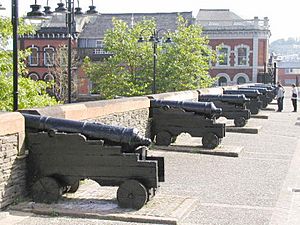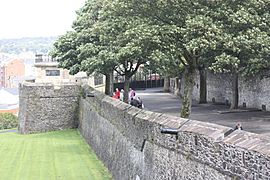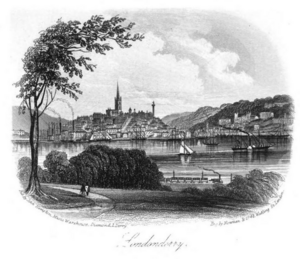Siege of Derry facts for kids
Quick facts for kids Siege of Derry |
|||||||
|---|---|---|---|---|---|---|---|
| Part of the Williamite War | |||||||
 Cannons on the walls of Derry |
|||||||
|
|||||||
| Belligerents | |||||||
| Commanders and leaders | |||||||
George Walker |
|||||||
| Strength | |||||||
| ~8,000 | ~21,000 | ||||||
| Casualties and losses | |||||||
| 4,000 killed (mostly by disease) or wounded | |||||||
The Siege of Derry in 1689 was a very important event in the Williamite War in Ireland. It happened after an earlier attempt to take the town in December 1688. That attempt failed when 13 young apprentices bravely shut the city gates. This was an act of rebellion against King James II.
The main siege started on April 18, 1689. King James himself arrived with an Irish army. The army was led by officers loyal to James and some from France. They asked the people of Derry to give up, but the city refused. The siege began. The attackers tried to storm the city walls but couldn't get in. So, they tried to starve the city instead. The siege finally ended when supply ships managed to break through to the town. The siege lasted for 105 days, from April 18 to August 1, 1689. Many Protestants in Northern Ireland remember this event every year.
Contents
Why the Siege Happened
The Siege of Derry was part of a bigger conflict called the Williamite War in Ireland. This war was connected to an even larger war in Europe, the Nine Years' War.
A New King for England
In 1688, a big change happened in England. King James II was overthrown in what was called the "Glorious Revolution". He was replaced by William of Orange. James II then fled to France. The King of France, Louis XIV, supported James. He needed James and his supporters, known as the Jacobites, as allies in his war against other European countries.
Ireland's Loyalty Divided
At this time, Ireland was ruled by Richard Talbot. He was loyal to King James II. Tyrconnell had put many Catholics in important positions in the Irish army and government. Because of this, most Irish Catholics stayed loyal to James. Many Irish Protestants, however, supported the new King William.
Tyrconnell tried to control those who supported William. By late 1688, only the Protestants in Ulster (Northern Ireland) were still resisting. Two towns in Ulster, Enniskillen and Derry, became key places in the early part of the war.
The Apprentice Boys' Brave Act
King James II asked Tyrconnell to send Irish soldiers to England. To replace them, Tyrconnell started new regiments. One of these was for Ulster, led by Alexander MacDonnell. He hired 1,200 Scottish Catholic soldiers.
Derry's Gates Shut
Derry had a Protestant regiment led by Viscount Mountjoy. Tyrconnell thought this regiment might not be loyal. So, he ordered them to leave Derry. MacDonnell's new regiment was supposed to replace them, but they were delayed. This left Derry without many soldiers.
On December 7, 1688, MacDonnell's soldiers were about to enter Derry. But 13 young apprentices quickly grabbed the city's keys and locked the gates. This act showed that Derry was openly against Tyrconnell and King James II. MacDonnell's forces were not strong enough to take the city, so they left.
Before the Siege Began
Some people think the apprentices' action started the siege. But actually, about six peaceful months passed before the real siege began in April 1689.
Preparing for Defense
After the gates were shut, a man named Colonel George Philips became the temporary governor of Derry. Later, Tyrconnell sent Viscount Mountjoy back to Derry. Mountjoy made a deal with the city: two of his companies, made up of Protestants, could enter.
Mountjoy then made Robert Lundy the governor of Derry. Lundy worked to prepare the city for a fight. He repaired the walls and gates, fixed cannons, and bought gunpowder. He also cleared buildings outside the walls that could hide attackers.
King James Arrives in Ireland
On March 12, King James II landed in Kinsale, on Ireland's south coast. He came with a French fleet and many French officers. He brought money and supplies, but not many soldiers. France needed its soldiers for the war in Europe. James met Tyrconnell and then went to Dublin.
When Derry heard James had arrived, they got ready to defend themselves. A ship from England, the Deliverance, brought gunpowder, weapons, and money. It also brought official papers from King William and Queen Mary, confirming Lundy as governor.
The Siege Begins
Tyrconnell and King James decided they had to take Derry. On April 2 or 3, a large army of about 12,000 soldiers marched north towards Derry. King James followed them on April 8.
Fighting at the River Finn
On April 13, soldiers from James's army were seen near Derry. Governor Lundy called a meeting. They decided to defend a line along the River Finn, southwest of Derry. Soldiers were placed at different crossing points.
On April 15, James's cavalry attacked this line. At one crossing, Clady, the cavalry managed to cross the river and defeat the defenders. This was a setback for Derry.
Governor Lundy's Decision
On the same day, English reinforcements arrived at Lough Foyle. Colonel Cunningham and Colonel Richards came with ships carrying about 1,600 men. Cunningham was told to follow Lundy's orders.
Lundy, feeling defeated after the fighting at the river, believed Derry could not be held. He held a meeting, but he didn't invite most of the local commanders. He suggested that the new troops should not land and that the city should be given up. He claimed there wasn't enough food to defend it.
Everyone at the meeting agreed. Lundy tried to keep this a secret. But people in the town saw many important officers getting ready to leave and board the ships. Cunningham's fleet waited for Lundy, but then left without him. Lundy himself later left the city in disguise and sailed to Scotland.
King James at the Walls
After breaking through the river defenses, James's army reached Derry on April 18. They demanded that the city surrender. The defenders asked for two days to think about it. They also said James's army should stay far away.
However, King James himself rode closer to the walls. He thought the people would surrender to their King. But the defenders saw this as breaking their agreement. When James and his group came within 300 yards of Bishops Gate, the city's cannons fired at them.
People shouted "No surrender!" One of James's helpers was killed by a shot from the city's largest cannon, the "Roaring Meg". James asked three more times for surrender, but was refused each time.
On the same day, Adam Murray, a brave soldier who had fought at the river, managed to get into the city with his cavalry unit. He broke through the enemy lines and entered through Shipquay Gate.
On April 19, the city council appointed Henry Baker as the new governor of Derry. George Walker was put in charge of the city's supplies.
Fierce Fighting and Losses
On April 21, the people of Derry, led by Murray, attacked the besiegers. They killed a French general named Maumont. Command then went to Richard Hamilton. On April 23, Fort Culmore, which guarded the entrance to the River Foyle, surrendered to James's forces.
During another attack by the besieged on April 25, two important enemy leaders were wounded, and another general was killed.
On May 6, James's forces attacked Windmill Hill, a key position outside Bishops Gate. They took it, but Governor Baker knew how important it was. The next day, the besieged attacked and took Windmill Hill back. Several enemy officers were captured or killed. Baker then built new earth walls to protect the city better.
The Boom Across the River
On May 30, the besiegers received heavy cannons and mortars. These powerful weapons fired nearly 600 explosive shells into the town.
Life inside the city became very hard. People started getting sick, and food was running out. It was clear that the city needed help. King William sent Major-General Percy Kirke to relieve Derry.
Kirke sent a small ship, HMS Greyhound, to explore the mouth of the River Foyle. On June 8, the Greyhound ran aground near Fort Culmore and was damaged by cannon fire. It managed to escape, but the mission showed that the besiegers had placed a huge barrier, called a boom, across the river. This boom was made of logs and chains, stopping ships from reaching Derry.
On June 17, Kirke sailed from Liverpool with three warships and 24 transport ships, carrying about 3,000 soldiers. This fleet arrived in Lough Foyle in early June. The people in Derry saw them from the cathedral tower on June 13, giving them hope.
Kirke thought he didn't have enough soldiers to fight the besiegers on land. And the incident with the Greyhound showed how dangerous it was to try to reach the city by river.
Rosen's Cruelty
To speed up the siege, King James sent another general, Conrad de Rosen, to Derry. Rosen arrived between June 17 and 24. He made the bombardment worse and even tried to dig a tunnel under a part of the wall.
On July 2, Rosen did something very cruel. He gathered Protestants from the surrounding areas and forced them to stand under the city walls. He hoped this would make the people inside surrender. The besieged responded by threatening to kill their own prisoners. When King James heard about this, he was angry and called Rosen "barbarous."
On June 30, Governor Baker died from illness. John Mitchelburne became the new governor of Derry.
The Relief of Derry
Finally, Frederick de Schomberg, a top commander for King William, ordered Kirke to attack the boom.
On July 28, Kirke sent four ships to try and bring food into Derry. These were HMS Dartmouth and three merchant ships: Mountjoy, Phoenix, and Jerusalem. The Dartmouth, led by Captain John Leake, fired at the enemy cannons on the shore. Meanwhile, the Mountjoy, commanded by Michael Browning, bravely crashed into the boom and broke it!
After the boom was broken, the Mountjoy and Phoenix sailed up to Derry. They unloaded many tons of food, saving the city.
Seeing that he could no longer starve Derry, and without enough soldiers to storm the city, Rosen decided to give up the siege. On August 1, the people of Derry discovered that the enemy army was gone. On August 3, Kirke reported the good news to London.
The city had survived a siege of 105 days, from April 18 to August 1. About 4,000 of the 8,000 defenders died during this time, mostly from disease and hunger.
| Key Dates of the Siege | ||
|---|---|---|
| All dates here are in the old style calendar. | ||
| 1688, Dec 7 | The apprentices shut the gates. | |
| 1689, Mar 12 | King James II landed in Ireland. | |
| 1689, Mar 20 | Captain James Hamilton brought supplies to Derry. | |
| 1689, Apr 15 | James's army forced their way across the River Finn. | |
| 1689, Apr 18 | King James appeared before the city; the siege officially began. | |
| 1689, Apr 19 | Henry Baker was appointed governor. | |
| 1689, Apr 21 | General Maumont was killed. | |
| 1689, Apr 23 | Fort Culmore surrendered. | |
| 1689, May 6 | General Ramsay was killed at Windmill Hill. | |
| 1689, May 30 | Heavy siege cannons arrived and started firing. | |
| 1689, Jun 3 | The boom was placed across the river. | |
| 1689, Jun 8 | HMS Greyhound explored the river mouth. | |
| 1689, Jun 13 | Major General Kirke's fleet arrived in Lough Foyle. | |
| 1689, Jun 2nd half | General Rosen arrived to take charge of the siege. | |
| 1689, Jun 28 | Clancarty attacked the Butcher's Gate. | |
| 1689, Jun 30 | Governor Baker died; Mitchelburne became governor. | |
| 1689, Jul 2 | Rosen forced Protestant civilians to the walls. | |
| 1689, Jul 29 | Supply ships broke through to the town. | |
| 1689, Aug 1 | James's army abandoned the siege and left. | |
Remembering the Siege
The Siege of Derry is a very important part of the history and traditions of Protestants in Northern Ireland. It is remembered with two main parades each year.
Shutting-of-the-Gates Parade
The brave act of the 13 apprentices shutting the gates on December 7, 1688, is remembered every year on the first Saturday of December. This day is sometimes called "Lundy's Day." The Apprentice Boys of Derry, a Protestant group, organizes this event.
The day often starts with cannon shots from the walls at midnight. Then, there's a ceremony where people touch the four original city gates. On Saturday, members of the Apprentice Boys clubs march through the city to St Columb's Cathedral for a special service. After the service, they lay a wreath at the Siege Heroes Mound. Finally, an effigy (a dummy) of Lundy is burned, showing him as a traitor.
Relief-of-Derry Parade
The end of the siege, on August 1, 1689, is celebrated with the Relief of Derry parade. This usually happens on the second Saturday of August. This date is chosen because it's close to August 11, which is the modern calendar equivalent of August 1. This parade is part of the week-long Maiden City Festival.
In 1714, Governor Mitchelburne started a tradition of raising a crimson flag on the cathedral steeple to mark the anniversary. This continued for many years. While there have been some conflicts during these parades in the past, recent ones have been mostly peaceful.
Important Memorials
- Walker's Pillar: This was a tall monument built between 1826 and 1828 to honor Reverend George Walker. It was a column with a statue of him on top. Sadly, it was blown up in 1973, but its base still remains.
- Browning Memorial Plaque: This plaque is on the city wall in Guildhall Square. It remembers Michael Browning, the brave captain of the Mountjoy ship. The top of the plaque shows his ship. The words on the plaque describe his heroic death as "the most enviable of all deaths."
The popular song "Derry's Walls" also remembers the siege. The chorus goes:
- We'll fight and don't surrender
- But come when duty calls,
- With heart and hand and sword and shield
- We'll guard old Derry's Walls.





